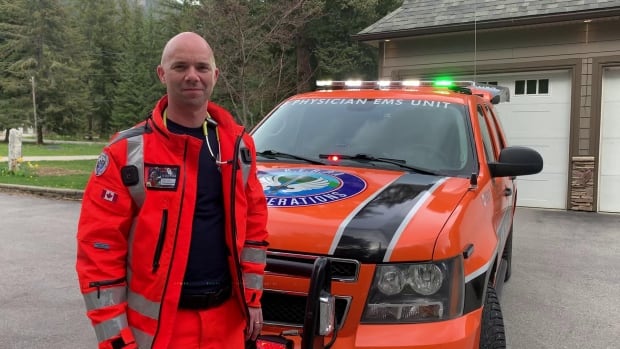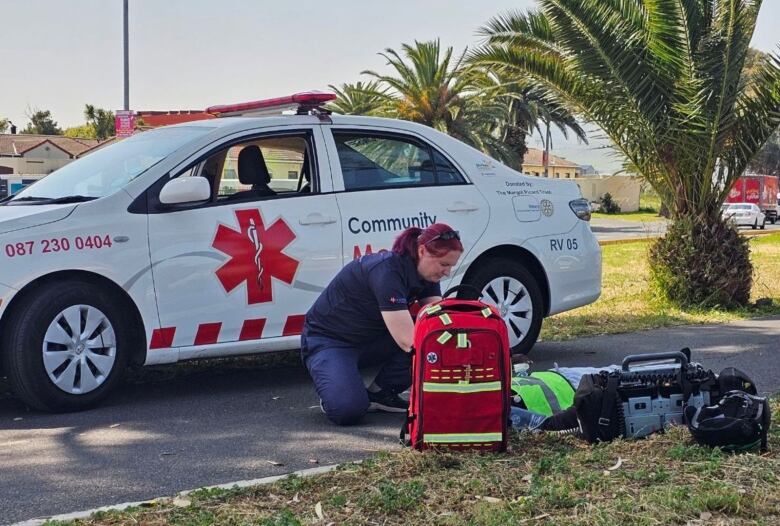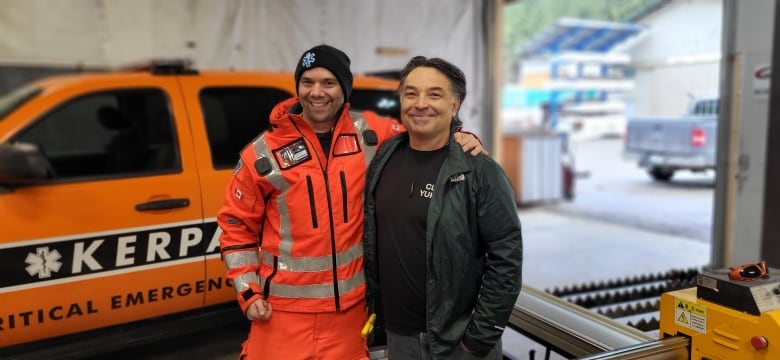
White Coat Black Art26:30Bringing the emergency department to the trauma scene
There’s an area on Highway 3 near Nelson, B.C., that Dr. Nicholas Sparrow knows well. There are no markers or special features, but he can easily find where he helped a person in an accident get out of their vehicle with broken femurs in both legs.
A broken femur can cause a person to lose up to 1.5 litres of blood, so he had to work fast.
“Potentially now this is a major, major trauma with potential for blood loss,” he recently told Dr. Brian Goldman, host of CBC’s White Coat, Black Art.
The patient was airlifted to a nearby trauma unit and recovered. But that incident is one of many Sparrow has responded to on that highway as an emergency response physician.
Some emergency responders both locally and nationally say Sparrow is doing something different in Canada. He’s a physician who volunteers in his off-hours, responding to emergency calls in the field through the Kootenay Emergency Response Physicians Association (KERPA), a charity he created in 2014.
When immediate threat-to-life calls come in, he hops in his orange Chevrolet Tahoe outfitted with about $200,000 worth of equipment funded by the community and grants.
Firefighters say having him in the Kootenays with his gear and abilities — which include administering certain medicines on scene that paramedics can’t — benefits patients.
“He’s able to delay or slow down the clock … so there’s time to get the patient to the hospital. And that’s a big thing in rural communities especially,” said Len Coates, a volunteer firefighter with the Ootischenia Fire Department in Castlegar, B.C.

Emergency response physicians exist in other countries like England, Sparrow says. But there are few — if any — responding on the ground to emergency calls in Canada.
“It’s a very appealing concept. In terms of a model though, there’s a lot of challenges of why it’s not, I suspect, broadly done,” said Dr. Fraser Mackay, an emergency physician at New Brunswick’s Saint John Regional Hospital.
He says the unpaid work is a challenge, along with finding doctors to do this work, especially considering many rural or remote communities across Canada are already struggling to find staff for local emergency departments.
“If a service like this existed where I am, would I be happy to take a couple of days a month and offer my services for free? Yeah, I probably would,” Mackay said.
“But could I commit a significant proportion of my time to that in addition to fulfilling my clinical needs in the local emergency departments? That’s a very different question.”
Why does he do it?
Sparrow was inspired to start KERPA because of an incident he saw as a child. A family friend with Red Cross first aid training saved his younger sister who was found in cardiac arrest in a pond.
“If a Red Cross first aider can volunteer their time and save the life of someone, then so can an emerg physician be utilized to save the lives and community as well,” he said.
Sparrow says helping people runs in his blood, and believes that emergency physicians can work alongside paramedics in the field to better help communities.
“Having physicians who are almost cross-trained in EMS to go and help I think is a very smart contingency plan for the country,” he said.
Wesley Craig, the training manager for South Africa’s Community Medics, says what Sparrow is doing is “an incredible story.”

Most of their volunteers in Capetown and nearby urban areas are lay people trained to stabilize patients in cardiac arrest or vehicle accidents until an ambulance arrives.
Craig says the small number of community medics who work in health care are seldom able to volunteer.
“They have their own work which is extremely demanding and comes with its own issues of PTSD, burnout, all the other issues that may come with working full time in that field,” he said.
In B.C., Sparrow says it wasn’t easy setting up the charity, with training requirements, funding, to acquiring medication and equipment all taking time.
In an emailed statement, a spokesperson with B.C.’s Health Ministry said B.C. Emergency Health Services signed agreements outlining how they work with KERPA, similar to those signed with search and rescue groups and fire departments.
As part of that agreement, B.C.’s emergency system dispatches Sparrow via pager when KERPA’s services are needed. He also has a hand-held radio that picks up calls in the area, which he can attend after connecting with dispatch.
Sparrow says KERPA is first on scene in about eight per cent of the calls they respond to, which includes collisions, ATV accidents, or cardiac arrests.
For the first eight years of KERPA, Sparrow was responding to calls when he wasn’t working full time in the Nelson emergency department. He now works three to six shifts per month at the hospital so he can focus more on the charity.
Last year was KERPA’s busiest year yet. Sparrow was available to respond to 314 incidents, with his medical skills and equipment used in 76 of those calls.
But with that increased demand comes the increased emotional toll of responding to intense calls.
“That takes a bit of processing power to work through in the midst of working in the emerg, being married, and having six kids,” he said.
Sparrow says he’s driven to continue by how he can help people, like former patient Mirek Hladik.
Hladik, who owns an aluminum fabrication company in Nelson, almost lost his foot in 2022 after 20 cement panels used for siding fell on him.
“Dr. Sparrow came up and I asked him ‘Nick, it’s going to be chop-chop?'” Hladik said.

Sparrow remembers Hladik’s foot was “pulseless and going quite pale.”
Sparrow did a procedure in the parking lot of Hladik’s shop so the circulation came back, giving paramedics time to get Hladik to the nearest trauma unit.
Today, Hladik has 90 per cent mobility in his foot.
“These kinds of accidents happen out of the blue, and you just have to have a good team of people to help you when it happens,” Hladik said.
Sparrow has been the only doctor with KERPA, but says another physician is currently doing the months-long training, which includes tactical medical and emergency vehicle operations training. The additional education is needed for accreditation and to provide critical care like surgical procedures at the roadside.
Sparrow says the second physician will allow him to share the growing call load. In the past, his children and wife say he’s left during birthdays or on Christmas morning if a call came in.
“I can’t help them, but he can. So my way of helping is letting him go,” said his wife, Krista.
Should this be elsewhere in Canada?
Sparrow hopes to see more sustainable funding for emergency physicians to respond in the field going forward.
For Mackay, better integrating pre-hospital care with emergency departments in Canada is key. He says pre-hospital care, like EMS, is often siloed with different funding, management and planning than other health-care services.
He says integrating the systems might go a long way in creating “more efficiencies and ultimately, better care for the patients in their time of need.”
Sparrow adds that if it ever comes to a point where no other physicians are interested in volunteering, then KERPA dies with him.
“It’s still not going to be in vain because we’ve helped a lot of people.”